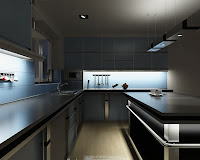Built-in lighting uses a site built structure (ie. a valance, cabinet or bulk-head) to control the beam and diffuse or focus the light to create a different atmosphere in the room or function for the light.
Under Cabinets:
Want to avoid that pesky shadow while preparing food or using your countertop? Here is where under cabinet lighting is key. There are three main types of lamps suited for this application which include fluorescent tubes, xenon strips and led strips. As illustrated in the photo above, tubes and strips will provide continuous light, whereas pucks, which are less common, will provide more of a spot light feel on the countertop. You will also want to ensure your contractor mounts the lamps near the front edge under the wall cabinets so they throw light directly on the countertop.
Above Cabinets, Coves and Valances:
 Ideal for soft, ambient lighting, cabinets or horizontal baffles running around the room below the ceiling can hide strip lighting. Light is directed onto the wall or ceiling where it is diffused and reflected back out to the room. The illustration below shows how the light will be reflected in a variety of installations.
Ideal for soft, ambient lighting, cabinets or horizontal baffles running around the room below the ceiling can hide strip lighting. Light is directed onto the wall or ceiling where it is diffused and reflected back out to the room. The illustration below shows how the light will be reflected in a variety of installations. 
For more great suggestions and help with your renovation, please contact our team at Interiors With Elegance. We look forward to hearing from you!

